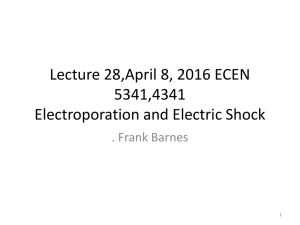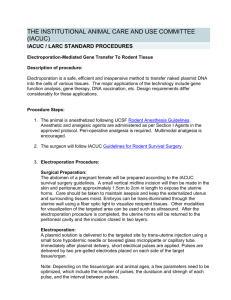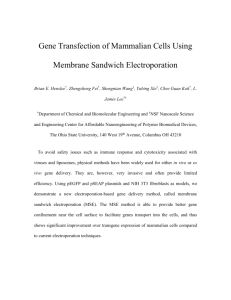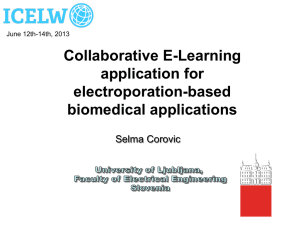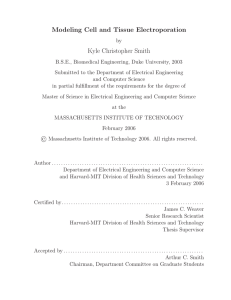ECEN 5031/4031 April 25,20 Electroporation and Electric Shock
advertisement
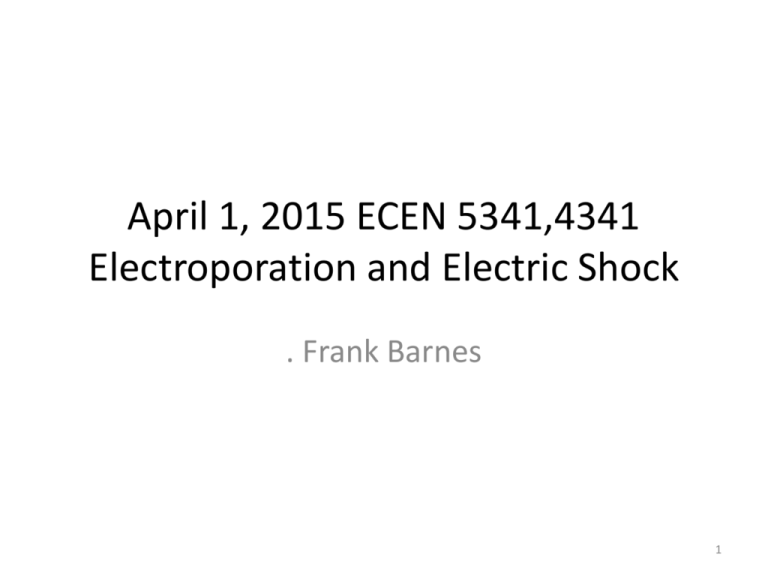
April 1, 2015 ECEN 5341,4341 Electroporation and Electric Shock . Frank Barnes 1 . ECEN 5031/4031 Electroporation Chapter 9 Vol. 2 1. Creating small holes in membranes with short electrical pulses. Typical pulses are 1µs< τ< 50ms and the required membrane voltages are between 0.2V < Um <1V 2.The membrane concentrates the electric field as it has a low conductivity σ = 10-7 S/m and low dielectric εr =2 constant compared to the inside of a cell and the fluid around it. σ = 1S/m, and εr=80 Electroporation • 1. High electric fields short pulse duration to punch holes in membranes. • 2. This allows us to pass molecules into the cell such as DNA and chemo therapeutic agents into a cell 3 Applications 1. 2. 3. Inserting DNA, proteins , drugs Fusing two cells Born energy is the energy to move from the fluid to the center of the membrane Na+ 2rs=0.4nm Membrane thickness d = 5nm 4 Born Energy The forces are largely local so that Where Km is the relative dielectric constant of the membrane and Kw is that of water Spontaneous crossing of large molecules negligible For rise times faster than moving charges or 3ns or f>300 MHz distributed E field 6 For slower rise times 10 sec most of the voltage is across the membranes The field strength E = 0.1 to 1kV/cm and 10kV/cm for bacteria to get 0.2 to 1.5V in 1μs to 10ms. Models Parallel plate capacitor ReCm where Re = resistance of the electrolyte and Cm = membrane capacity The E field across the membrane depends on the length of the pulse Em Um 0.1V 7 2 x 10 V /m 9 d m 5 x10 5 An Electroporation System • Gene Pulser Xcell™ Electroporation Systems 6 Specifications Gene Pulser Xcell™ Total System Includes main unit, CE module, PC module, and ShockPod™ cuvette chamber Outputs Waveform: Exponential or square Voltage: 10–3,000 V Capacitance 10–500 V, 25–3,275 µF in 25 µF increments 500–3,000 V, 10, 25, 50 µF Resistance (parallel) 50–1,000 Ω in 50 Ω increments, plus infinity Sample resistance 20 Ω minimum at 10–2,500 V 600 Ω minimum at 2,500–3,000 V Square-wave timing 10–500 V: 0.05–10 ms in 0.05 ms increments, 10–100 ms pulse in 1 ms increments, 1–10 pulses, 0.1–10 sec interval 500–3,000 V: 0.05–5 ms in 0.05 ms increments, 1–2 pulses, 5 sec minimum interval 7 Another Electroporation Device • 1 8 Pulse Characteristics • 1. Creating a small hole in the membrane. • 2. Pulses 0.2V<V< 1V 1µs<τ<50ms • E Membrane εm =2-4εo Cell interior εi =50-80εo 9 Pulse Characteristics • 1. Times greater than 1µs required to concentrate the charges and fields. • 2. Fields greater than 0.1KV/cm often greater than 1KV/cm. Field varies with position on the cell surface. • 3. High fields and short pulses give the best results 10 Typical Pulse 11 Fields for a Spherical Cell 12 Pore Formation 4 Stages • 1. Charging the membrane • 2. Constant Voltage Vm , small currents • 3. Fluctuating current as transition to long lived excited state,10minutes large σ, low V • 4. Increase in pulse length leads to saturation and irreversible damage. log10 τm ~ Vm 13 A Molecular Dynamics Simulation 14 Some Theory for Pore Formation 15 Pore Formation Dynamics 16 Ion Transport Through a Pore 17 Some Theories for Electroporation • 1. Hydrodynamic Flow • 2. Compression • 3. Pores that lead to membrane weakness that is local. • 4. Pore formation becomes significant from thermal processes plus applied field when • Um >~ 0.5 V 18 Reversible Pore Formation • 1. Vm≈ 1V τm≈ 400ns rp≈ 0.8nm • 2. R drops by 109 • 3. Rapid discharge and the membrane reforms. • 4. Relaxation times for a fluid τf=εf/σf – for saline τ f τ≈ 0.5ns much less than the charging time Vm 50µs 0.4 19 Energy • 1. Energy of a charge in the medium W 1 2 E V 2 The essential barrier function of cell membranes can be represented by a thin sheet of lipid. To move a charge through the membrane W e2 [ 1 8 o rs m 1 w ] 100kT 20 Forces • 1. E Fields on the Membranes are a function of time. Increase and then Decrease • 2. Force the opening in the pores that expand with time. • 3. E fields drive currents and carry along neutral molecules. 21 Membrane Recovery • 1. Reported times vary from nanoseconds to minutes or hours. • 2. Strongly depends on Temperature • 3. Depends on the size of the pore also on what molecules or ions are being transported. 22 Cell Stress And Survival • 1. Cell survival and stress are mainly to exchange of molecules with the environment. Chemical or ion imbalances. • 2. Cells can be killed without significant heating. • 3. There is a fuzzy threshold for the transport of molecules into or out of the cells and not a large margin to cell death. • 4. Transport is not very selective with respect to molecules or ions. • 5. Survival seems to go with the ratio of the external volume to the internal volume of the cell. In vitro Vex/Vin is large and favors cell death In vivo it is the reverse with Vex/Vin≈0.15 • 6. This mean that in vivo cell damage for the same pulses are less likely. 23 Tissue Electroporation and In Vivo Delivery • 1 A purposeful electroporation of tissue in vivo and in vitro has been motivated by therapeutic interventions such as tumor treatment by delivery of anticancer drugs ,gene therapy by delivery of DNA, and other genetic material and delivery of various sized molecules into and across the skin • 2. Also tissue electroporation may be relevant to • neuromuscular incapacitation (stunning) pulses 24 Voltage Concentration in Tissue • 1. Voltage concentration in tissue needs to be across the membranes. • 2. For preferential electroporation, two features should be sought: • (I) tissue barriers comprised mainly of lipids • (ii) mechanical deformability (compliance) of membranes comprise of the particular lipids so that the electrostatically favored entry of water into a deformable phospholipid-based membrane results in the creation of aqueous pathways. • 25 Current Flows in Tissue. • 1. At low fields most of the current flows around the cell membranes. • 2. After electroporation much of the current flows through the cell. • 3 Tumor tissue is an important example of tissue for which many cells have intercellular aqueous pathways. Even without electroporation there is a significant physiological resistance to entry of anticancer drugs because of limited blood perfusion, elevated interstitial pressure, and relatively large distances to blood vessels 26 Application to Tumors. • 1. Without electroporation there is a significant physiological resistance to entry of anticancer drugs because of limited blood perfusion, elevated interstitial pressure, and relatively large distances to blood vessels 2. Local tissue electroporation should create aqueous pathways that assist drug movement and that may also relieve pressure, but the fourth power dependence of volumetric flow on pathway size implies that significant water flow may be more difficult than diffusion and drift of small drugs. 27 Applications • 1. Electroporation has value largely in cancer treatment for drugs that to not go through the membranes naturally. Bleomycin is an example where electroporation helps. • 2. Transdermal Drug delivery through skin. – The stratum corneum is the main barrier plus sweat ducts and hair follicles. • 3. The double cell lining of sweat ducts should experience electroporation at about U =2 to 4 V, but the approximately 100 bilayers of the SC need U =50 to 100V for pulses with duration of 100 ms to 1 ms, i.e., about 0.5 to 1V per lipid bilayer barrier barrier 28 Skin • Experiments of this type with human skin show that if exponential pulses with Voltage across SC,0 50 to 300V and time constant, t, pulse 1 ms are applied every 5 s for 1 h, then there is an enhancement by up to a factor of 104 in the flux of charged molecules of up to about 1 kDa Companion electrical impedance measurements show a rapid (25 ms) decrease in skin resistance and both molecular flux and electrical measurements show that either reversible or irreversible behavior occurs, depending on the transdermal pulse amplitude, Voltage SC, 0. Several in vivo experiments show that transdermal delivery can be achieved with minimal damage. 29 Gene Therapy • 1. Gene therapy also requires movement of large molecules through the cell walls. • 2. You only need succeed with some of the cells to be effective. Smaller longer pulses. • 3. Concerns about damage. • 4. Surfactants can improve membrane recovery. 30 Electroporation of Organelles • 1 Short high field pulses (ns) Um = 1.2V • E= 106V/m • 2. Many small pores in outer membrane as well as in the organelle 31 Electric Shocks Trauma • 1. 21% of the burns in 2000-2001 • 2. Electrocution 5th leading cause of death for occupational injuries • 3. More than 90% of these injuries for utility workers occur in men, mostly between the ages of 20 and 34, with 4 to 8 y of experience on the job [4]. • 4. For survivors, the injury pattern is very complex, with a high disability rate due to accompanying neurologic damages and loss of limbs. 32 Low Voltage Shocks 1. Low voltage shocks < 1000 V mostly minor neural damage. • 2. Low-voltage shocks are more likely to produce a prolonged, ‘‘no-let-go’’ contact with the power source. This ‘‘no-let-go’’ phenomenon is caused by an involuntary, current-induced, muscle spasm. For 60 Hz electrical current the ‘‘no-letgo’’ threshold for axial current passage through the forearm is 16 mA for males and 11 mA for females 33 Lightning • There are roughly 200 human deaths annually in the United States due to lightning strikes and there are three times those many who survive. The range of lightning injury extent is quite broad, depending upon the magnitude of exposure and the condition of the victim. Usually lightning hits result in surface burns, complex neurological damage similar to blunt head trauma, peripheral neurologic injury, and cardiac damage 34 Current Flow +RF • 1 Current flow is along the paths of low resistance. In the extra cellular medium and in long cells as they have a small fractional volume of membrane. • 2. At RF and Microwaves membranes are less of barrier and the absorption coefficient and dielectric constants. determine the distributions of currents. 35 AC vs DC • Alternating current (AC) is more dangerous than direct current (DC), and 60-cycle current is more dangerous than high-frequency current. AC is said to be four to five times more dangerous than DC because AC causes more severe muscular contraction. In addition, AC stimulates sweating that lowers the skin resistance. Humans and animals are most susceptible to frequencies at 50 to 60 hertz because the internal frequency of the nerve signals controlling the heart is approximately 60 hertz. (Electric Shock Precautions) 36 37 Physiological Effects of Shock Table 1. Physiological Effects of Shock Electric Current (1sec. Contact) Physiological Effect Voltage required to produce the current with assumed body resistance: 100,000 ohms 1,000 ohms 1 mA Threshold of feeling, tingling sensation. 100 V 1V 5 mA Accepted as maximum harmless current. 500 V 5V Beginning of sustained muscular contraction ("Can't let go” current). 1000 V 10 V Ventricular fibrillation, fatal if continued. Respiratory function continues. 10,000 V 100 V Sustained ventricular contraction followed by normal heart rhythm (defibrillation). Temporary respiratory paralysis and possibly burns. 600,000 V 6000 V 10-20 mA 100-300 mA 6A 38 Safety Guide Lines • 1 The National Electrical Code (NEC) in the U.S. considers 5 mA (0.005Amps) to be a safe upper limit for children and adults; hence the 5 mA Ground Fault Interrupter (GFI) circuit breaker requirement for wet locations. (The Physical Effects of Electricity) The values in Table 1 should be used as a guide instead of absolute data points. For instance, 99% of the female populations have a “let go” limit above 6 mA with an average of 10.5 mA. 99% of the male populations have a “let go” above 9 mA, with an average of 15.5 mA. (The Physical Effects of Electricity) Ventricular fibrillation can occur at current levels as low as 30 mA for a two year old child and 60 mA for adults. Most adults will go into ventricular fibrillation at hand to hand currents below 100 mA (0.1 Amp). (The Physical Effects of Electricity) 39 Will the 120 volt common household voltage produce a dangerous shock? It depends! • • • • • • • • • • • • • • If your body resistance is 100,000 ohms, then the current which would flow would be: I = 120 volts = .0012 A = 1.2 mA 100,000 Ω This is just about at the threshold of perception, so it would only produce a tingle. If one had just played a couple of sets of tennis, and is sweaty and barefoot, then the resistance to ground might be as low as 1000 ohms. Then the current would be: I = 120 volts 1,000 Ω = .12A = 120 mA This is a lethal shock, capable of producing ventricular fibrillation and death! The severity of shock from a given source will depend upon its path through the body. (Nave & Nave) 40 Body Resistance Table 2. Typical Human Body Resistance to Electrical Current Body Area Resistance (ohms) Dry Skin 100,000 to 600,000 Wet Skin 1,000 Internal body (hand to foot) Ear to Ear 400 to 600 ~100 Table 2 shows some of the typical human body resistances to electrical current. Barring broken skin, body-circuit resistance, even in contact with liquid, will probably be not less than 500 ohms. However, the current flow at this resistance and 120 volts is 240 mA—over twice what is required to cause death. (Biological Effects of Electric Shock) 41 Mechanism vs Frequency 42 Current Flow 43 Tissue Damage Thresholds 1KV/cm to 60 V/cm for long nerve or muscle cells 44 Electrical Damage • A burn from electrocution is much different than a burn from scalding or fire. Fleshy tissue is destroyed at 122° F and vascular tissue serving the nerves suffers damage at considerably less. Victims of industrial high-voltage accidents will present to the emergency room with obvious thermal destruction at the skin contact points. The extremities may be slightly swollen and otherwise without visible surface damage. Yet beneath the involved skin, the skeletal muscle will often exist in a state of severe unrelenting spasm or rigor. There will be frequently marked sensory and motor nerve malfunction. Within the first week after injury, many victims will undergo sequential surgical procedures to remove damaged nonviable skeletal muscle, resulting in a weak, stiff extremity that is often anesthetic because of nerve damage, and cold because of poor circulation. Under these circumstances, the patient is better off by undergoing amputation and then receiving a prosthetic extremity. (R. Lee 223-230) 45 Muscle Damage • In general, muscle and nerve appear to be the tissues with the greatest vulnerability to injury by electrical current. There is a characteristic skeletal muscle tissue injury pattern in victims of high-voltage electrical shock which is relatively unique to shock victims. Muscle adjacent to the bone and joints is recognized clinically to be the most vulnerable to electrical trauma. In addition, muscle cells located in the central region of the muscle may also be vulnerable and nerves seem to have a lower threshold for damage than muscle. • (R. Lee 223-230) • 46 MRI Image 47
